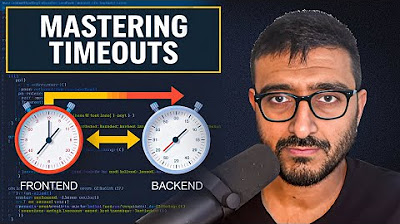When do you use threads?
Summary
TLDRThe video discusses the intricacies of backend processing, focusing on connection management and throughput. It highlights the challenges faced by CDNs in accepting multiple connections, emphasizing the need for efficient handling to avoid bottlenecks and timeouts. The speaker explains the benefits and complexities of using multithreading, including the role of mutexes in preventing race conditions. Additionally, the concept of port sharding is introduced as a solution to enhance connection acceptance by allowing multiple threads to manage their own queues. Overall, the video offers valuable insights into optimizing server performance in concurrent environments.
Takeaways
- 😀 Increasing backend throughput can be achieved by using multiple threads to handle requests more efficiently.
- 📈 Throughput is impacted by various factors, including the nature of the requests being processed.
- 🔗 Connection acceptance is a critical challenge for CDNs and reverse proxies, requiring fast processing to avoid bottlenecks.
- ⚙️ The 'accept' system call introduces overhead due to its serial handling of incoming connections.
- ⏳ Slow connection acceptance can lead to clients timing out if requests pile up in the accept queue.
- 🧵 Spawning multiple threads can help mitigate connection acceptance issues by allowing concurrent processing.
- 🔒 Mutexes are necessary for thread safety but can lead to contention and performance issues if multiple threads access shared resources.
- 🧩 Debugging multithreaded applications is complex due to potential race conditions and shared resource access problems.
- 📦 Socket sharding can enhance performance by allowing multiple threads to listen on the same IP address and port.
- 🔄 The SO_REUSEPORT option enables separate accept queues for each thread, improving connection distribution and reducing contention.
Q & A
What is throughput in the context of backend processing?
-Throughput refers to the number of requests a backend can process in a given time frame, typically measured in requests per second.
How can threading improve backend throughput?
-Threading allows multiple requests to be processed simultaneously, increasing the potential throughput by dividing the workload across several threads.
What challenges arise when accepting connections in a CDN?
-The primary challenge is the speed at which connections can be accepted, as the process involves several tasks like connection handshakes and encryption, which can create bottlenecks.
What happens if the accept queue fills up?
-If the accept queue fills up, incoming connections may time out, leading to lost client connections and a failure to establish new connections.
What is the accept mutex and why is it important?
-The accept mutex is a locking mechanism that ensures only one thread can call the accept function at a time, preventing race conditions but potentially causing contention among threads.
What is socket sharding, and how does it help with connection acceptance?
-Socket sharding allows multiple threads to listen on the same IP and port but have separate listener sockets, which helps reduce contention and allows the kernel to distribute connections more efficiently.
What are some downsides of using threads in backend applications?
-Using threads can complicate debugging, introduce locking issues, and require careful management of shared resources to prevent race conditions.
Why is it crucial to manage connections quickly in a CDN?
-Quick management of connections is essential to avoid filling the accept queue and timing out client requests, which can impact the overall performance and reliability of the service.
How does the kernel handle connections in a sharded socket scenario?
-In a sharded socket setup, the kernel distributes incoming connections across multiple accept queues, allowing each thread to manage its own connections without interfering with others.
What should developers consider when implementing multi-threading?
-Developers should consider potential contention, the complexity of debugging multi-threaded applications, and the necessity of proper synchronization mechanisms like mutexes to ensure thread safety.
Outlines

此内容仅限付费用户访问。 请升级后访问。
立即升级Mindmap

此内容仅限付费用户访问。 请升级后访问。
立即升级Keywords

此内容仅限付费用户访问。 请升级后访问。
立即升级Highlights

此内容仅限付费用户访问。 请升级后访问。
立即升级Transcripts

此内容仅限付费用户访问。 请升级后访问。
立即升级5.0 / 5 (0 votes)






